Weekly Forex Forecast - Sunday, Dec. 3
Image Source: Unsplash
The difference between success and failure in Forex trading is highly likely to depend upon which assets you choose to trade each week and in which direction, and not on the exact methods you might use to determine trade entries and exits.
So, when starting the week, it is often a good idea to look at the big picture of what is developing in the market as a whole, and how such developments are affected by macro fundamentals, technical factors, and market sentiment.
Fundamental Analysis & Market Sentiment
I wrote in my previous piece Nov. 26 that the best trade opportunities for the week were likely to be:
- Long of the Nasdaq 100 Index. This rose by 0.22% last week.
- Long of cocoa futures. This rose by 1.72% last week.
These trades produced an overall average win of 0.82%.
Last week was once again dominated by a rise in risk-on sentiment that gave a tailwind to a further decline in the US dollar, which arguably has established a new long-term bearish trend. Some gauges of investor risk sentiment reached their highest levels in almost two years, but Friday saw Fed Chair Powell cast doubt on the prospect of rate hikes in the near future, leading to a risk sell-off at the end of the week.
There were several important data releases last week which impacted the market. US Preliminary GDP data came in higher than expected, at 5.2%, while the US Core PCE Price Index came in as expected. Perhaps most importantly, German, Spanish, and Australian inflation data were all lower than expected and falling. This set of data helped boost risk-on sentiment.
The other major data release last week was the Reserve Bank of New Zealand’s policy meeting, which saw rates left unchanged at the relatively high level of 5.50%. However, the bank made a hawkish tilt by leaving open the prospect of further rate hikes within the current cycle, which boosted the New Zealand dollar.
Other important data releases within last week’s schedule were as follows:
- Chinese Manufacturing PMI – this came in very slightly lower than expected.
- OPEC Meetings – production cuts were agreed, but crude oil prices fell regardless.
- Canadian GDP – this came in very slightly higher than expected.
- US CB Consumer Confidence – this came in slightly higher than expected.
- US Unemployment Claims – this came in as expected.
- US ISM Manufacturing PMI – this came in slightly lower than expected.
- Canadian Unemployment – this came in as expected.
The Week Ahead: Dec. 4-8, 2023
The coming week in the markets is likely to see a lower level of volatility, as there will be fewer highly-important data releases, excepting the US non-farm payrolls numbers. This week’s key data releases are, in order of importance, as follows:
- US Non-Farm Payrolls, Average Hourly Earnings, and Unemployment Rate
- Bank of Canada Rate Statement and Overnight Rate
- RBA Cash Rate and Rate Statement
- US JOLTS Job Openings
- US ISM Services PMI
- Swiss CPI (inflation)
- US Preliminary UoM Consumer Sentiment
- Australian GDP
- US Unemployment Claims
- Chinese CPI (inflation)
Technical Analysis - US Dollar Index
The US Dollar Index printed a weakly bullish pin bar last week, which rejected the support level shown in the price chart below which I had identified at 102.38. However, the weekly close was once again below the prices of both three and six months ago, demonstrating a valid, long-term bearish trend. These are mixed signs.
This recent dollar bearishness was supported by the lower-than-expected US inflation data released three weeks ago, which suggests that the Fed will now be working to cut rates rather than raise them. However, this was tempered on Friday by Jerome Powell’s remarks casting doubt on any near-term rate cuts by the Fed, although further hikes seem extremely improbable.
I think the dollar will fall further in the near-term, but perhaps not over the course of the coming week. We may well see a technically driven small rise in the greenback now, or a consolidation above the support level at 102.38. This may result in a tricky week for any Forex trades involving the US dollar.
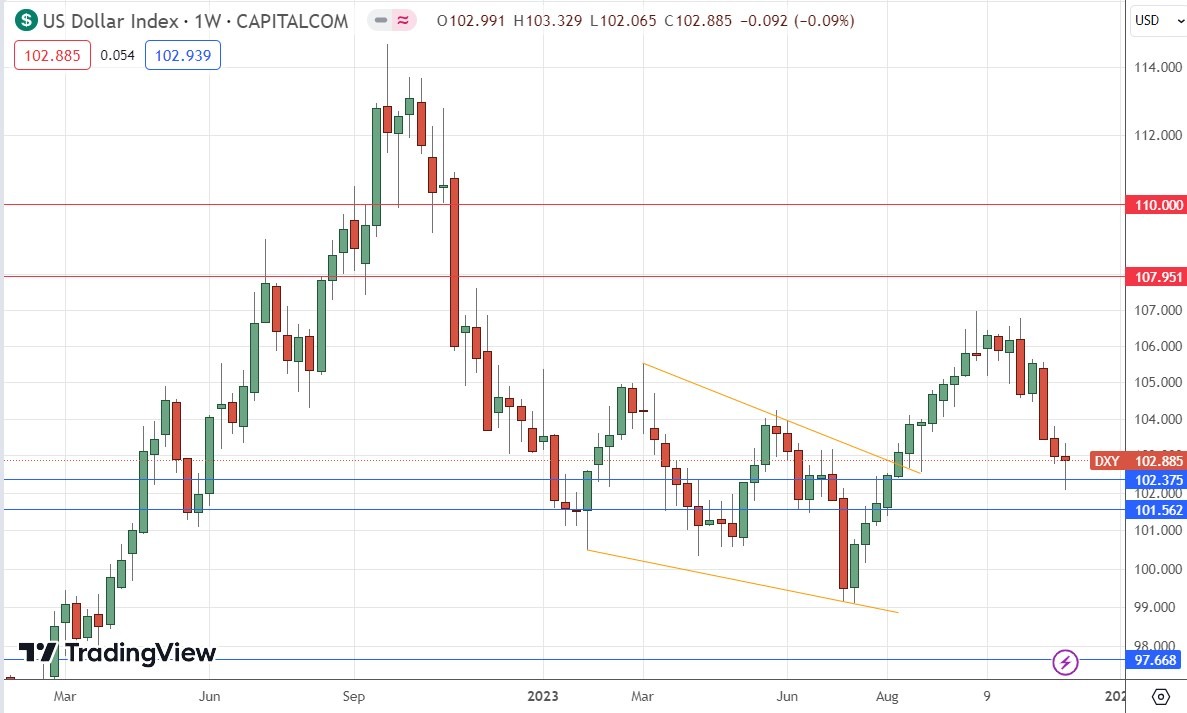
(Click on image to enlarge)
USD/JPY
The USD/JPY currency pair made a strong downwards move last week. The body of the weekly candlestick engulfed a lot of recent price action, and the weekly close was right on the low.
These are bearish signs, and the bearish momentum looks quite strong here, so although there is not an overall trend, we can say that there may be some more bearish movement at least during the first few days of this coming week.
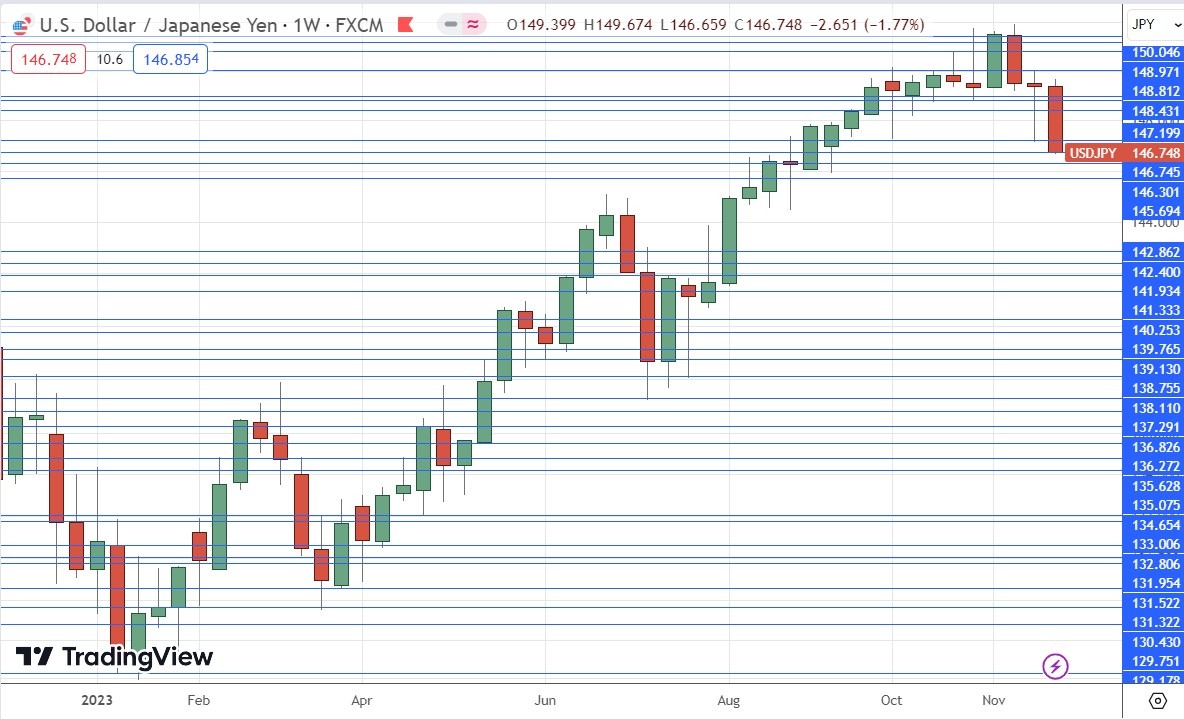
(Click on image to enlarge)
USD/CHF
The USD/CHF currency pair also made a strong downwards move last week. The body of the weekly candlestick engulfed a lot of fairly recent price action, and the weekly close was right on the low. These are similarly bearish signs. Although this currency pair does not move reliably, there is a long-term bearish trend here, and the price is not far from a long-term low at $0.8552.
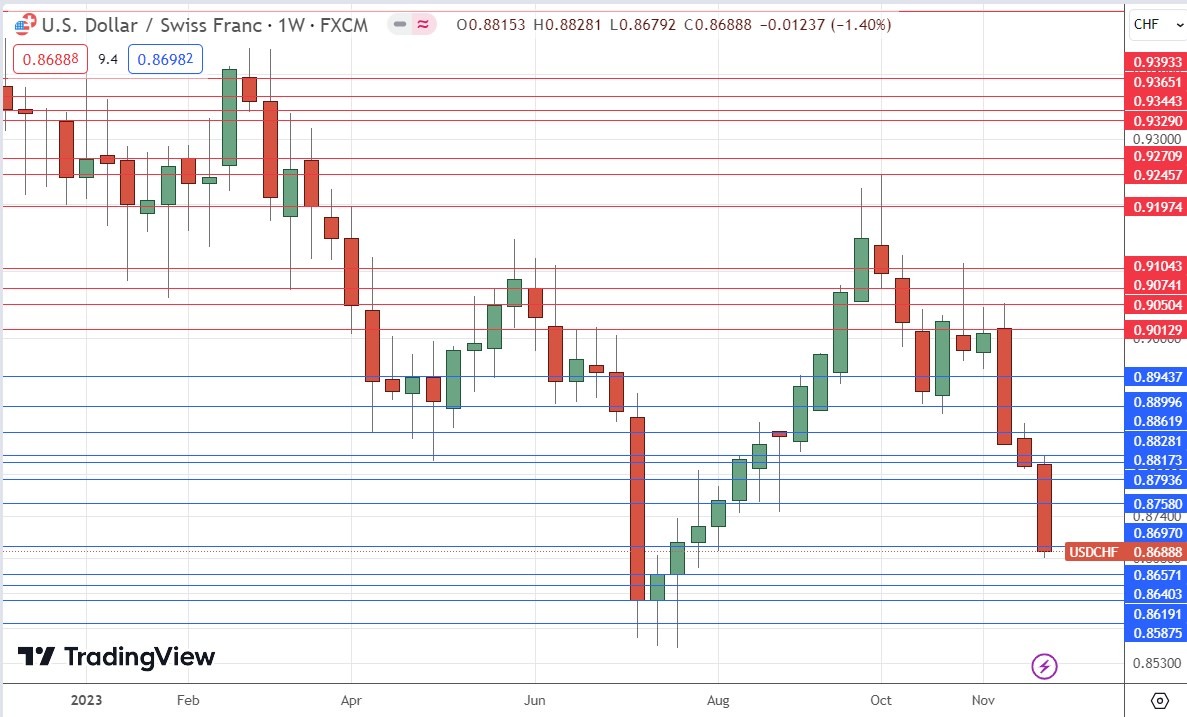
(Click on image to enlarge)
NZD/USD
The NZD/USD currency pair printed a strong, solid bullish candlestick over the week, closing very near the high of its range. The price ended the week by marking its highest weekly close in almost four months. The kiwi was one of the strongest major currencies last week.
These are bullish signs, given a further push by the fact that the price is now in a long-term bullish trend. However, this currency pair does not typically trend very reliably. Another concern for bulls should be the strong area of resistance above $0.6300, which might act as a cap on any significant further advance.
However, there is definitely bullish momentum here that looks likely to continue to some extent as the new week gets underway in the market.

(Click on image to enlarge)
Nasdaq 100 Index
The Nasdaq 100 Index printed a fifth successive bullish candlestick, making its highest weekly close in 22 months, and it once again traded at its highest price seen since January 2022. Despite these bullish facts, the momentum slowed considerably last week, but we clearly have a bull market here, which is breaking to new highs. However, the fact that the weekly candlestick is clearly a doji should give bulls cause for concern.
The Nasdaq 100 Index has historically been a great investment on the long side, especially during a bull market, and with this latest break to a new high, we seem to have a signal saying it makes sense to be long here.
I am happy to be long of the Nasdaq 100 Index, but due to the declining momentum, only after a daily close at a new 22-month high.
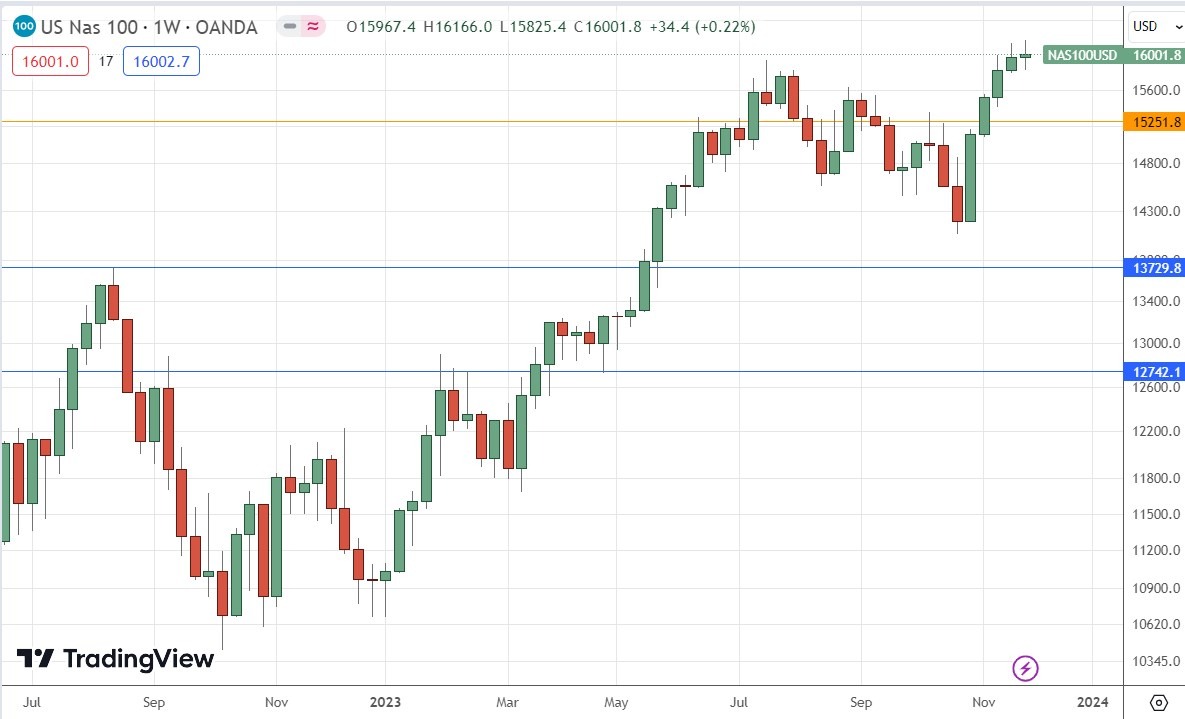
(Click on image to enlarge)
Cocoa Futures
Cocoa futures have been in a strong bullish trend for over a year now, and they made another strong rise last week. The price chart below applies a linear regression analysis to the past 62 weeks, and it shows graphically what a great opportunity this has been on the long side.
The weekly candlestick was once again very bullish. It is always a bit aggressive to enter without a pullback, especially right now with the price action above the upper band of the linear regression channel, but this is a strong trend that shows no sign of stopping on ever-increasing global demand for cocoa.
Trading commodities long on breakouts to new six-month highs has been a very profitable strategy over recent years.
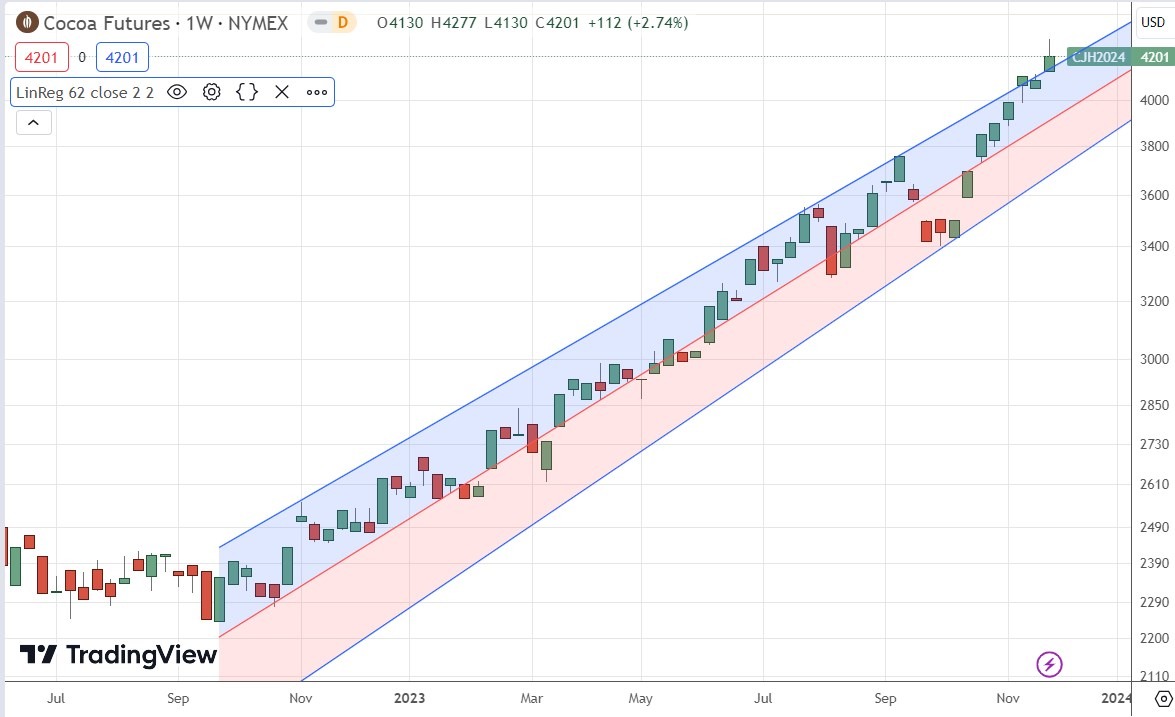
(Click on image to enlarge)
Bottom Line
I see the best trading opportunities this week as:
- Long of the Nasdaq 100 Index following a daily close above 16166.
- Long of cocoa futures following a daily close above 4277.
More By This Author:
Crude Oil: Weekly Forecast December 3-9Trading Support and Resistance – USD/CAD
AUD/USD Forex Signal: Aussie Has More Upside Ahead of US PCE Report
Disclosure: See the full disclosure for DailyFX here.




